User:RMCD bot/subject notice Reading is a complex "cognitive process" of decoding symbols in order to construct or derive meaning (reading comprehension). Reading is a means of language acquisition, communication, and of sharing information and ideas. The symbols are typically visual (written or printed) but may be tactile (Braille). Like all languages, it is a complex interaction between the text and the reader which is shaped by the reader’s prior knowledge, experiences, attitude, and language community which is culturally and socially situated. The reading process requires continuous practice, development, and refinement. In addition, reading requires creativity and critical analysis. Consumers of literature make ventures with each piece, innately deviating from literal words to create images that make sense to them in the unfamiliar places the texts describe. Because reading is such a complex process, it cannot be controlled or restricted to one or two interpretations. There are no concrete laws in reading, but rather it allows readers an escape to produce their own products introspectively. This promotes deep exploration of texts during interpretation. Readers use a variety of reading strategies to assist with decoding (to translate symbols into sounds or visual representations of speech) and comprehension. Readers may use context clues to identify the meaning of unknown words. Readers integrate the words they have read into their existing framework of knowledge or schema. Other types of reading are not speech based writing systems, such as music notation or pictograms. The common link is the interpretation of symbols to extract the meaning from the visual notations or tactile signals (as in the case of Braille).
- visual representations
- braille
- literature
1. Overview

Currently most reading is either of the printed word from ink or toner on paper, such as in a book, magazine, newspaper, leaflet, or notebook, or of electronic displays, such as computer displays, television, mobile phones or e-readers. Handwritten text may also be produced using a graphite pencil or a pen. Short texts may be written or painted on an object.
Often the text relates to the object, such as an address on an envelope, product info on packaging, or text on a traffic or street sign. A slogan may be painted on a wall. A text may also be produced by arranging stones of a different color in a wall or road. Short texts like these are sometimes referred to as environmental print.
Sometimes text or images are in relief, with or without using a color contrast. Words or images can be carved in stone, wood, or metal; instructions can be printed in relief on the plastic housing of a home appliance, or myriad other examples.
A requirement for reading is a good contrast between letters and background (depending on colors of letters and background, any pattern or image in the background, and lighting) and a suitable font size. In the case of a computer screen, it is important to be able to see an entire line of text without scrolling.
The field of visual word recognition studies how people read individual words.[1][2][3] A key technique in studying how individuals read text is eye tracking. This has revealed that reading is performed as a series of eye fixations with saccades between them. Humans also do not appear to fixate on every word in a text, but instead pause on some words mentally while their eyes are moving. This is possible because human languages show certain linguistic regularities.
The process of recording information to be read later is writing. In the case of computer and microfiche storage there is the separate step of displaying the written text. For humans, reading is usually faster and easier than writing.
Reading is typically an individual activity, although on occasion a person will read out loud for the benefit of other listeners. Reading aloud for one's own use, for better comprehension, is a form of intrapersonal communication: in the early 1970s[4] has been proposed the dual-route hypothesis to reading aloud, accordingly to which there were two separate mental mechanisms, or cognitive routes, that are involved in this case, with output of both mechanisms contributing to the pronunciation of a written stimulus.[4][5][6]
Reading to young children is a recommended way to instill language and expression, and to promote comprehension of text. Personalised books for children are recommended to improve engagement in reading by featuring the child themselves in the story.
Before the reintroduction of separated text in the late Middle Ages, the ability to read silently was considered rather remarkable.[7]
2. Reading Skills
Literacy is the ability to use the symbols of a writing system. It is the ability to interpret what the information symbols represent, and to be able to re-create those same symbols so that others can derive the same meaning. Illiteracy is the inability to derive meaning from the symbols used in a writing system. Dyslexia refers to a cognitive difficulty with reading and writing. It is defined as brain-based type of learning disability that specifically impairs a person's ability to read.[8] The term dyslexia can refer to two disorders: developmental dyslexia[9][10][11][12] which is a learning disability; alexia (acquired dyslexia) refers to reading difficulties that occur following brain damage, stroke, or progressive illness.[13][14]
Major predictors of an individual's ability to read both alphabetic and nonalphabetic scripts are phonological awareness, rapid automatized naming and verbal IQ.[15] Being taught to read at an early age (such as five years old) does not ultimately result in better reading skills, and if it replaces more developmentally appropriate activities, then it may cause other harms.[16]
2.1. Reading Rate
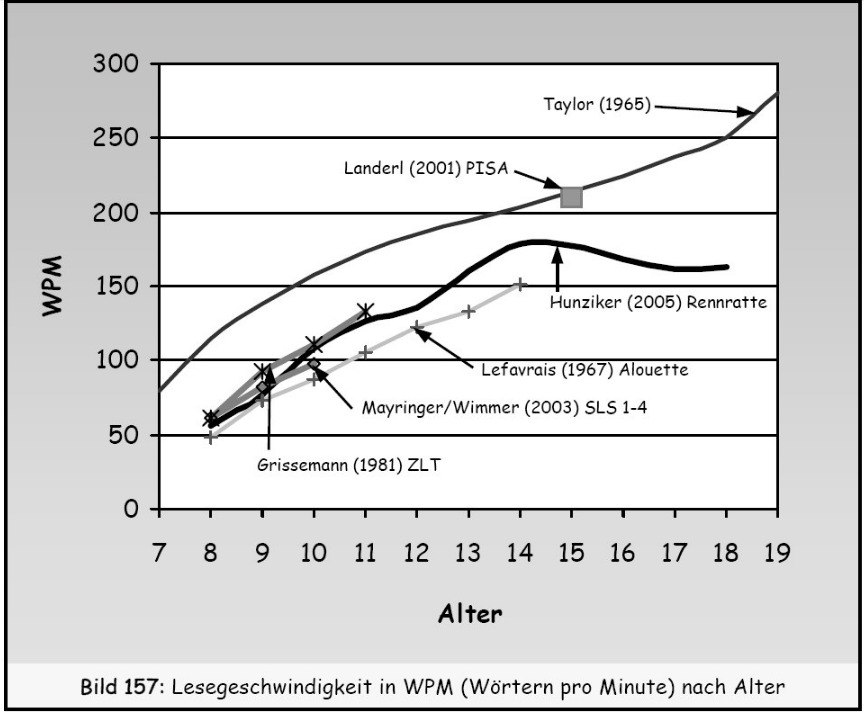
Many studies have shown that increasing the reading rate will improve reading comprehension.[17]Reading speed requires a long time to reach adult levels. The table to the right shows how reading-rate varies with age,[18] regardless of the period (1965 to 2005) and the language (English, French, German). The Taylor values probably are higher, for disregarding students who failed the comprehension test. The reading test by the French psychologist Pierre Lefavrais ("L'alouette", published in 1967) tested reading aloud, with a penalty for errors, and could, therefore, not be a rate greater than 150 wpm. According to Carver (1990), children's reading speed increases throughout the school years. On average, from grade 2 to college, reading rate increases 14 standard-length words per minute each year (where one standard-length word is defined as six characters in text, including punctuation and spaces).[19] Note that the data from Taylor (English) and Landerl (German) are based on texts of increasing difficulty; other data were obtained when all age groups were reading the same text.
Rates of reading include reading for memorization (fewer than 100 words per minute [wpm]); reading for learning (100–200 wpm); reading for comprehension (200–400 wpm); and skimming (400–700 wpm). Reading for comprehension is the essence of the daily reading of most people. Skimming is for superficially processing large quantities of text at a low level of comprehension (below 50%).
Advice for choosing the appropriate reading-rate includes reading flexibly, slowing when concepts are closely presented and when the material is new, and increasing when the material is familiar and of thin concept. Speed reading courses and books often encourage the reader to continually accelerate; comprehension tests lead the reader to believe his or her comprehension is continually improving; yet, competence-in-reading requires knowing that skimming is dangerous, as a default habit.
Scientific studies have demonstrated that reading—defined here as capturing and decoding all the words on every page—faster than 900 wpm is not feasible given the limits set by the anatomy of the eye.[20]
Reading speed has been used as a measure in research to determine the effect of interventions on human vision. A Cochrane Systematic Review used reading speed in words per minute as the primary outcome in comparing different reading aids for adults with low vision.[21]
2.2. Skill Development

Both lexical and sub-lexical cognitive processes contribute to how we learn to read.
Sub-lexical reading,[22][23][24][25] involves teaching reading by associating characters or groups of characters with sounds or by using phonics or synthetic phonics learning and teaching methodology, sometimes argued to be in competition with whole language methods.
Lexical reading[22][23][24][25] involves acquiring words or phrases without attention to the characters or groups of characters that compose them or by using whole language learning and teaching methodology. Sometimes argued to be in competition with phonics and synthetic phonics methods, and that the whole language approach tends to impair learning how to spell.
Other methods of teaching and learning to read have developed, and become somewhat controversial.[26]
Learning to read in a second language, especially in adulthood, may be a different process than learning to read a native language in childhood. There are cases of very young children learning to read without having been taught.[27] Such was the case with Truman Capote who reportedly taught himself to read and write at the age of five. There are also accounts of people who taught themselves to read by comparing street signs or Biblical passages to speech. The novelist Nicholas Delbanco taught himself to read at age six during a transatlantic crossing by studying a book about boats.
Brain activity in young and older children can be used to predict future reading skill. Cross model mapping between the orthographic and phonologic areas in the brain are critical in reading. Thus, the amount of activation in the left dorsal inferior frontal gyrus while performing reading tasks can be used to predict later reading ability and advancement. Young children with higher phonological word characteristic processing have significantly better reading skills later on than older children who focus on whole-word orthographic representation.[28]
2.3. Methods of Reading

There are several types and methods of reading, with differing rates that can be attained for each, for different kinds of material and purposes:
- Subvocalized reading combines sight reading with internal sounding of the words as if spoken. Advocates of speed reading claim it can be a bad habit that slows reading and comprehension, but other studies indicate the reverse, particularly with difficult texts.[30][31]
- Speed reading is a collection of methods for increasing reading speed without an unacceptable reduction in comprehension or retention. Methods include skimming or the chunking of words in a body of text to increase the rate of reading. It is closely connected to speed learning.
- Incremental reading is a software-assisted reading method designed for long-term memorization. "Incremental reading" means "reading in portions": in each session, parts of several electronic articles are read inside a prioritized reading list. In the course of reading, important pieces of information are extracted and converted into flashcards which are then scheduled for review by a spaced repetition algorithm.
- Proofreading is a kind of reading for the purpose of detecting typographical errors. One can learn to do it rapidly, and professional proofreaders typically acquire the ability to do so at high rates, faster for some kinds of material than for others, while they may largely suspend comprehension while doing so, except when needed to select among several possible words that a suspected typographic error allows.
- Rereading is reading a book more than once. "One cannot read a book: one can only reread it," Vladimir Nabokov once said.[32] A paper published in the Journal of Consumer Research (Cristel Antonia (2012)) found re-reading offers mental health benefits because it allows for a more profound emotional connection and self-reflection, versus the first reading which is more focused on the events and plot.[33]
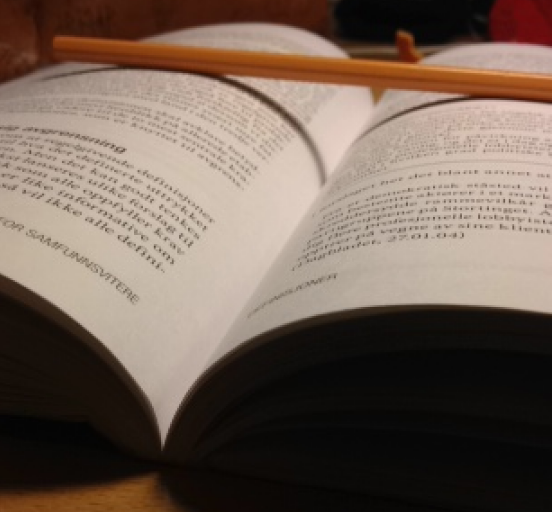
- Structure-proposition-evaluation (SPE) method, popularized by Mortimer Adler in How to Read a Book, mainly for non-fiction treatise, in which one reads a writing in three passes: (1) for the structure of the work, which might be represented by an outline; (2) for the logical propositions made, organized into chains of inference; and (3) for evaluation of the merits of the arguments and conclusions. This method involves suspended judgment of the work or its arguments until they are fully understood.
- Survey-question-read-recite-review (SQ3R) method, often taught in public schools, which involves reading toward being able to teach what is read, and would be appropriate for instructors preparing to teach material without having to refer to notes during the lecture.
- Multiple intelligences-based methods, which draw upon the reader's diverse ways of thinking and knowing to enrich his or her appreciation of the text. Reading is fundamentally a linguistic activity: one can basically comprehend a text without resorting to other intelligences, such as the visual (e.g., mentally "seeing" characters or events described), auditory (e.g., reading aloud or mentally "hearing" sounds described), or even the logical intelligence (e.g., considering "what if" scenarios or predicting how the text will unfold based on context clues). However, most readers already use several intelligences while reading, and making a habit of doing so in a more disciplined manner—i.e., constantly, or after every paragraph—can result in more vivid, memorable experience.
- Rapid serial visual presentation (RSVP) reading involves presenting the words in a sentence one word at a time at the same location on the display screen, at a specified eccentricity. RSVP eliminates inter-word saccades, limits intra-word saccades, and prevents reader control of fixation times (Legge, Mansfield, & Chung, 2001).[34] RSVP controls for differences in reader eye movement, and consequently is often used to measure reading speed in experiments.
Reading process is therefore a communication context.
3. Assessment
3.1. Types of Tests
- Sight word reading: reading words of increasing difficulty until they become unable to read or understand the words presented to them. Difficulty is manipulated by using words that have more letters or syllables, are less common and have more complicated spelling–sound relationships.
- Nonword reading: reading lists of pronounceable nonsense words out loud. The difficulty is increased by using longer words, and also by using words with more complex spelling or sound sequences.[35]
- Reading comprehension: a passage is presented to the reader, which they must read either silently or out loud. Then a series of questions are presented that test the reader's comprehension of this passage.
- Reading fluency: the rate with which individuals can name words.
- Reading accuracy: the ability to correctly name a word on a page.
Some tests incorporate several of the above components at once. For instance, the Nelson-Denny Reading Test scores readers both on the speed with which they can read a passage, and also their ability to accurately answer questions about this passage. Recent research has questioned the validity of the Nelson-Denny Reading Test, especially with regard to the identification of reading disabilities.[36]
4. Cognitive Benefits
Reading books and writing are among brain-stimulating activities shown to slow down cognitive decline in old age, with people who participated in more mentally stimulating activities over their lifetimes having a slower rate of decline in memory and other mental capacities.[37] Reading for pleasure has been linked to increased cognitive progress in vocabulary and mathematics during adolescence. [38][39] Moreover, the cognitive benefits of reading continue into mid-life and old age.[40][41][42]
5. Effects

5.1. Lighting
Reading from paper and from some screens requires more lighting than many other activities. Therefore, the possibility of doing this comfortably in cafés, restaurants, buses, at bus stops or in parks greatly varies depending on available lighting and time of day.
Reading from screens which produce their own light is less dependent on external light, except that this may be easier with little external light. For controlling what is on the screen (scrolling, turning the page, etc.), a touch screen or keyboard illumination further reduces the dependency on external light.
6. History

The history of reading dates back to the invention of writing during the 4th millennium BC. Although reading print text is now an important way for the general population to access information, this has not always been the case. With some exceptions, only a small percentage of the population in many countries was considered literate before the Industrial Revolution. Some of the pre-modern societies with generally high literacy rates included classical Athens and the Islamic Caliphate.[43]
Scholars assume that reading aloud (Latin clare legere) was the more common practice in antiquity, and that reading silently (legere tacite or legere sibi) was unusual.[44] In his Confessions, Saint Augustine remarks on Saint Ambrose's unusual habit of reading silently in the 4th century AD.[44][45]
During the Age of Enlightenment, elite individuals promoted passive reading, rather than creative interpretation. Reading has no concrete laws, but rather allows readers an escape to produce their own products introspectively, promoting deep exploration of texts during interpretation. Construction, or the creation of writing and producing a product, was believed to be a sign of initiative and active participation in society, while consumption or reading, was viewed as simply taking in what constructors made.[46] Also during this era, writing was considered superior to reading in society. Readers during this time were considered passive citizens, simply because they did not produce a product. Michel de Certeau argued that the elites of the Age of Enlightenment were responsible for this general belief. Michel de Certeau believed that reading required venturing into an author's land, but taking away what the reader wanted specifically. Writing was viewed as a superior art to reading during this period, due to the hierarchical constraints the era initiated.[46]
In 18th-century Europe, the then new practice of reading alone in bed was for some time considered dangerous and immoral. As reading became less of a communal, oral practice and more of a private, silent one, and as sleeping likewise more often took place in individual bedrooms rather than in communal sleeping areas, concerns were raised that reading in bed could give rise to various dangers, such as fires caused by bedside candles. Modern critics have argued, however, that these concerns were based on the fear that readers – especially women – could escape their familial and communal obligations and transgress moral boundaries by losing themselves in the private fantasy worlds that books made available.[47]
7. Gallery

Miss Auras, by John Lavery, depicts a woman reading a book
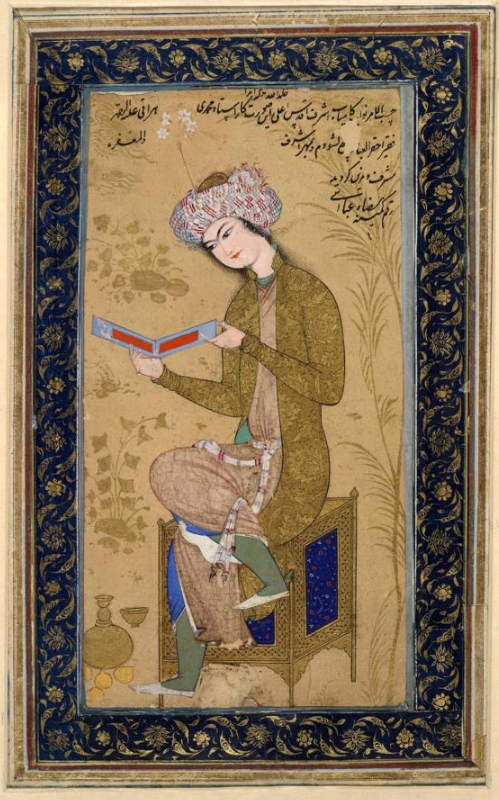
Youth reading, Persian miniature by Reza Abbasi (1625-6)
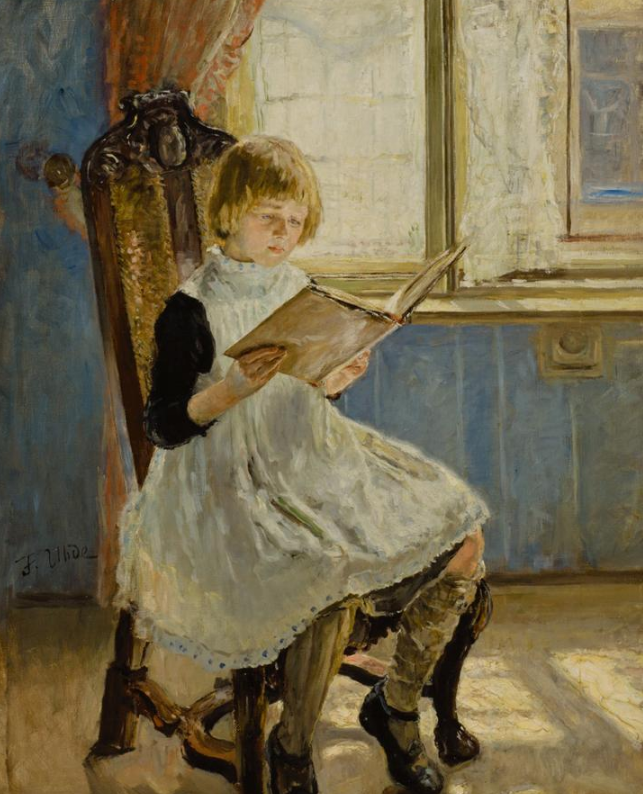
Girl Reading (1889), by Fritz von Uhde. Oil paint on canvas
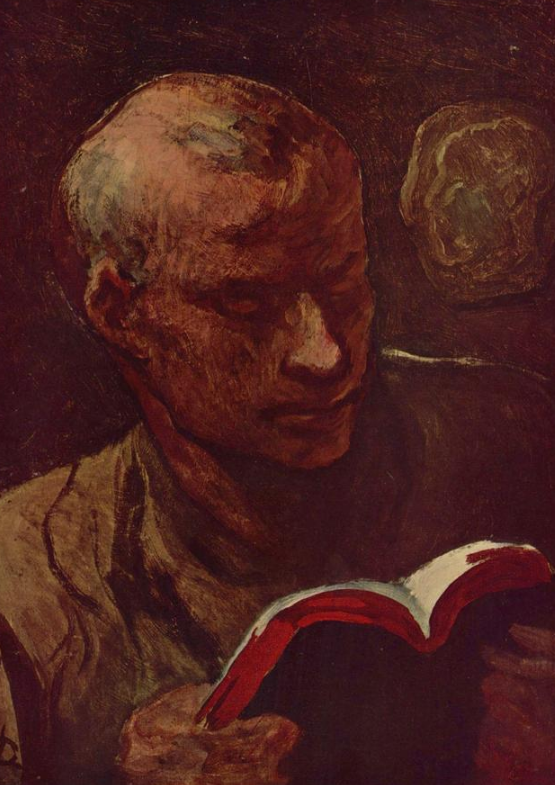
The content is sourced from: https://handwiki.org/wiki/Social:Reading_(process)
References
- Cornelissen PL, Kringelbach ML, Ellis AW, Whitney C, Holiday IE, Hansen PC; Kringelbach; Ellis; Whitney; Holliday; Hansen (2009). Aleman, André. ed. "Activation of the left inferior frontal gyrus in the first 200 ms of reading: evidence from magnetoencephalography (MEG)". PLoS ONE 4 (4): e5359. doi:10.1371/journal.pone.0005359. PMID 19396362. Bibcode: 2009PLoSO...4.5359C. http://www.pubmedcentral.nih.gov/articlerender.fcgi?tool=pmcentrez&artid=2671164
- Wheat KL, Cornelissen PL, Frost SJ, Hansen PC; Cornelissen; Frost; Hansen (April 2010). "During visual word recognition, phonology is accessed within 100 ms and may be mediated by a speech production code: evidence from magnetoencephalography". Journal of Neuroscience 30 (15): 5229–33. doi:10.1523/JNEUROSCI.4448-09.2010. PMID 20392945. http://www.pubmedcentral.nih.gov/articlerender.fcgi?tool=pmcentrez&artid=3419470
- Nation K (December 2009). "Form-meaning links in the development of visual word recognition". Philosophical Transactions of the Royal Society of London. Series B, Biological Sciences 364 (1536): 3665–74. doi:10.1098/rstb.2009.0119. PMID 19933139. http://www.pubmedcentral.nih.gov/articlerender.fcgi?tool=pmcentrez&artid=2846312
- "Nonword reading: comparing dual-route cascaded and connectionist dual-process models with human data". J Exp Psychol Hum Percept Perform 38 (5): 1268–88. October 2012. doi:10.1037/a0026703. PMID 22309087. https://dx.doi.org/10.1037%2Fa0026703
- Coltheart, Max; Curtis, Brent; Atkins, Paul; Haller, Micheal (1 January 1993). "Models of reading aloud: Dual-route and parallel-distributed-processing approaches". Psychological Review 100 (4): 589–608. doi:10.1037/0033-295X.100.4.589. https://dx.doi.org/10.1037%2F0033-295X.100.4.589
- "The use of the orthographic lexicon in reading kana words". J Gen Psychol 117 (3): 311–23. July 1990. PMID 2213002. http://www.ncbi.nlm.nih.gov/pubmed/2213002
- "THE SILENT READERS". http://www.stanford.edu/class/history34q/readings/Manguel/Silent_Readers.html. Retrieved 2013-06-20.
- "NINDS Dyslexia Information Page". National Institute for Neurological Disorders and Stroke. http://www.ninds.nih.gov/disorders/dyslexia/dyslexia.htm. Retrieved November 12, 2011.
- Heim S, Tschierse J, Amunts K; Tschierse; Amunts; Wilms; Vossel; Willmes; Grabowska; Huber (2008). "Cognitive subtypes of dyslexia". Acta Neurobiologiae Experimentalis 68 (1): 73–82. ISSN 0065-1400. PMID 18389017. http://www.ane.pl/linkout.php?pii=6809.
- Facoetti A; Lorusso ML; Paganoni P et al. (April 2003). "Auditory and visual automatic attention deficits in developmental dyslexia". Brain Res Cogn Brain Res 16 (2): 185–91. doi:10.1016/S0926-6410(02)00270-7. PMID 12668226. https://dx.doi.org/10.1016%2FS0926-6410%2802%2900270-7
- Ahissar M (November 2007). "Dyslexia and the anchoring-deficit hypothesis". Trends Cogn. Sci. (Regul. Ed.) 11 (11): 458–65. doi:10.1016/j.tics.2007.08.015. PMID 17983834. https://dx.doi.org/10.1016%2Fj.tics.2007.08.015
- Chung KK, Ho CS, Chan DW, Tsang SM, Lee SH; Ho; Chan; Tsang; Lee (February 2010). "Cognitive profiles of Chinese adolescents with dyslexia". Dyslexia 16 (1): 2–23. doi:10.1002/dys.392. PMID 19544588. http://www3.interscience.wiley.com/journal/122462213/abstract.
- Cherney LR (2004). "Aphasia, alexia, and oral reading". Top Stroke Rehabil 11 (1): 22–36. doi:10.1310/VUPX-WDX7-J1EU-00TB. PMID 14872397. *Temple CM (August 2006). "Developmental and acquired dyslexias". Cortex 42 (6): 898–910. doi:10.1016/S0010-9452(08)70434-9. PMID 17131596. https://dx.doi.org/10.1310%2FVUPX-WDX7-J1EU-00TB
- Sinanović O, Mrkonjić Z, Zukić S, Vidović M, Imamović K; Mrkonjić; Zukić; Vidović; Imamović (March 2011). "Post-stroke language disorders". Acta Clin Croat 50 (1): 79–94. PMID 22034787. http://www.ncbi.nlm.nih.gov/pubmed/22034787
- Powell D, Stainthorp R, Stuart M, Garwood H, Quinlan P; Stainthorp; Stuart; Garwood; Quinlan (September 2007). "An experimental comparison between rival theories of rapid automatized naming performance and its relationship to reading". Journal of Experimental Child Psychology 98 (1): 46–68. doi:10.1016/j.jecp.2007.04.003. PMID 17555762. https://dx.doi.org/10.1016%2Fj.jecp.2007.04.003
- Strauss, Valerie (13 January 2015). "Report: Requiring kindergartners to read — as Common Core does — may harm some". The Washington Post. https://www.washingtonpost.com/news/answer-sheet/wp/2015/01/13/report-requiring-kindergartners-to-read-as-common-core-does-may-harm-some/.
- Jodai, Hojat (August 2011). "Reading Rate and Comprehension". https://files.eric.ed.gov/fulltext/ED523331.pdf.
- Im Auge des Lesers, foveale und periphere Wahrnehmung: vom Buchstabieren zur Lesefreude(2006), ppgs. 117.
- Carver, Ronald P. (1990). Reading rate: a review of research and theory. Boston: Academic Press. ISBN 978-0-12-162420-0.
- Bremer, Rod (2016-01-20). The Manual: A Guide to the Ultimate Study Method (2 ed.). Fons Sapientiae Publishing. ISBN 978-0-9934964-0-0. https://books.google.com/?id=cEFKjwEACAAJ&dq=ultimate+study+method.
- Virgili G, Acosta R, Grover LL, Bentley SA, Giacomelli G; Acosta; Grover; Bentley; Giacomelli (2013). "Reading aids for adults with low vision". Cochrane Database Syst Rev 10 (10): CD003303. doi:10.1002/14651858.CD003303.pub3. PMID 24154864. http://www.pubmedcentral.nih.gov/articlerender.fcgi?tool=pmcentrez&artid=4288929
- Borowsky R, Esopenko C, Cummine J, Sarty GE; Esopenko; Cummine; Sarty (2007). "Neural representations of visual words and objects: a functional MRI study on the modularity of reading and object processing". Brain Topogr 20 (2): 89–96. doi:10.1007/s10548-007-0034-1. PMID 17929158. https://dx.doi.org/10.1007%2Fs10548-007-0034-1
- Borowsky R, Cummine J, Owen WJ, Friesen CK, Shih F, Sarty GE; Cummine; Owen; Friesen; Shih; Sarty (2006). "FMRI of ventral and dorsal processing streams in basic reading processes: insular sensitivity to phonology". Brain Topogr 18 (4): 233–9. doi:10.1007/s10548-006-0001-2. PMID 16845597. https://dx.doi.org/10.1007%2Fs10548-006-0001-2
- Sanabria Díaz G; Torres Mdel R; Iglesias J et al. (November 2009). "Changes in reading strategies in school-age children". Span J Psychol 12 (2): 441–53. doi:10.1017/S1138741600001827. PMID 19899646. https://dx.doi.org/10.1017%2FS1138741600001827
- Chan ST, Tang SW, Tang KW, Lee WK, Lo SS, Kwong KK; Tang; Tang; Lee; Lo; Kwong (November 2009). "Hierarchical coding of characters in the ventral and dorsal visual streams of Chinese language processing". NeuroImage 48 (2): 423–35. doi:10.1016/j.neuroimage.2009.06.078. PMID 19591947. https://dx.doi.org/10.1016%2Fj.neuroimage.2009.06.078
- Feitelson, Dina (1988). Facts and Fads in Beginning Reading: A Cross-Language Perspective. Norwood, New Jersey, United States: Ablex. ISBN 978-0-89391-507-0.
- Hughes, Diana; Stainthorp, Rhona (1999). Learning from children who read at an early age. New York: Routledge. ISBN 978-0-415-17495-4.
- McNorgan C, Alvarez A, Bhullar A, Gayda J, Booth JR; Alvarez; Bhullar; Gayda; Booth (June 2011). "Prediction of reading skill several years later depends on age and brain region: implications for developmental models of reading". The Journal of Neuroscience 31 (26): 9641–8. doi:10.1523/JNEUROSCI.0334-11.2011. PMID 21715629. PMC 3147303. http://www.jneurosci.org/cgi/pmidlookup?view=long&pmid=21715629.
- Hunziker, Hans-Werner (2006) (in German). Im Auge des Lesers foveale und periphere Wahrnehmung: vom Buchstabieren zur Lesefreude (In the eye of the reader: foveal and peripheral perception - from letter recognition to the joy of reading). Transmedia Zurich. ISBN 978-3-7266-0068-6.
- Moidel, Steve (1998). Speed Reading for Business. Hauppauge, NY: Barron's Educational. pp. 23–24. ISBN 978-0-7641-0401-5.
- Rayner, Keith (1995). The Psychology of Reading. Pollatsek, Alexander. London: Routledge. pp. 192–194. ISBN 978-0-8058-1872-7.
- Patricia Meyer Spacks (2011). On Rereading, Harvard University Press. ISBN:978-0-674-06222-1
- Rob Waugh. "Reading a book really is better the second time round - and can even offer mental health benefits", Daily Mail, 15 Feb 2012. http://www.dailymail.co.uk/sciencetech/article-2101516/Reading-book-really-better-second-time-round--reading-offer-mental-health-benefits.html
- "Psychophysics of reading. XX. Linking letter recognition to reading speed in central and peripheral vision". Vision Research 41 (6): 725–43. March 2001. doi:10.1016/S0042-6989(00)00295-9. PMID 11248262. https://dx.doi.org/10.1016%2FS0042-6989%2800%2900295-9
- Glavin, Chris (6 February 2014). "Reading Assessment - K12 Academics". http://www.k12academics.com/educational-psychology/reading-activity/reading-assessment#.WKHjtneZNo4.
- Coleman C, Lindstrom J, Nelson J, Lindstrom W, Gregg KN; Lindstrom; Nelson; Lindstrom; Gregg (2010). "Passageless comprehension on the Nelson-Denny reading test: well above chance for university students". J Learn Disabil 43 (3): 244–9. doi:10.1177/0022219409345017. PMID 19933897. https://dx.doi.org/10.1177%2F0022219409345017
- Koren, Marina (July 23, 2013). "Being a Lifelong Bookworm May Keep You Sharp in Old Age". Archived from the original on July 5, 2013. https://www.webcitation.org/6Ht0xyPkH?url=http://blogs.smithsonianmag.com/science/2013/07/being-a-lifelong-bookworm-may-keep-you-sharp-in-old-age/. which cites Wilson, Robert S. (July 3, 2013). "Life-span cognitive activity, neuropathologic burden, and cognitive aging (Abstract)". Archived from the original on July 5, 2013. https://www.webcitation.org/6Ht0Ia2PN?url=http://neurology.org/content/early/2013/07/03/WNL.0b013e31829c5e8a.
- "Reading for pleasure puts children ahead in the classroom". http://www.cls.ioe.ac.uk/news.aspx?itemid=2740&itemTitle=Reading+for+pleasure+puts+children+ahead+in+the+classroom%2C+study+finds&sitesectionid=27&sitesectiontitle=News&returnlink=news.aspx%3Fsitesectionid%3D27%26sitesectiontitle%3DNews%26from%3D01%2F09%2F2013%26to%3D01%2F10%2F2013%26range%3DSeptember%25202013/.
- Sullivan, A., Brown, M. (2015) "Reading for pleasure and progress in vocabulary and mathematics". British Educational Research Journal . http://onlinelibrary.wiley.com/doi/10.1002/berj.3180/abstract
- "Long term vocabulary benefits from 'reading for pleasure' in childhood". http://www.cls.ioe.ac.uk/news.aspx?itemid=3101&itemTitle=Long-term+vocabulary+benefits+from+%E2%80%98reading+for+pleasure%E2%80%99+in+childhood&sitesectionid=27&sitesectiontitle=News&returnlink=news.aspx%3Fsitesectionid%3D27%26sitesectiontitle%3DNews%26page%3D2/.
- Sullivan A.; Brown M. (2015). "Vocabulary from adolescence to middle age". Longitudinal and Life Course Studies 6 (2): 173–189. doi:10.14301/llcs.v6i2.310. http://llcsjournal.org/index.php/llcs/article/view/310.
- Bavishi A.; Slade MD.; Levy BR (2016). "A chapter a day: Association of book reading with longevity". Social Science & Medicine 164: 44 –48. doi:10.1016/j.socscimed.2016.07.014. PMID 27471129. PMC 5105607. http://www.sciencedirect.com/science/article/pii/S0277953616303689.
- Andrew J. Coulson. Delivering Education. Hoover Institution. p. 117. http://media.hoover.org/documents/0817928928_105.pdf. Retrieved 2008-11-22.
- Carruthers, Mary. 2008. The Book of Memory: A Study of Memory in Medieval Culture. 2nd. ed. Cambridge: Cambridge University Press, pp. 212 ff..
- Jajdelska, Elspeth. 2007. Silent Reading and the Birth of the Narrator. Toronto: University of Toronto Press, p. 5.
- De Certeau, Michel. "Reading as Poaching." The Practice of Everyday Life. Trans. Steven F. Rendall. Berkeley: University of California Press, 1984. 165-176.
- Mavrody, Nika (19 May 2017). "The Dangers of Reading in Bed". The Atlantic. https://www.theatlantic.com/technology/archive/2017/05/reading-in-bed/527388/. Retrieved 23 May 2017.
